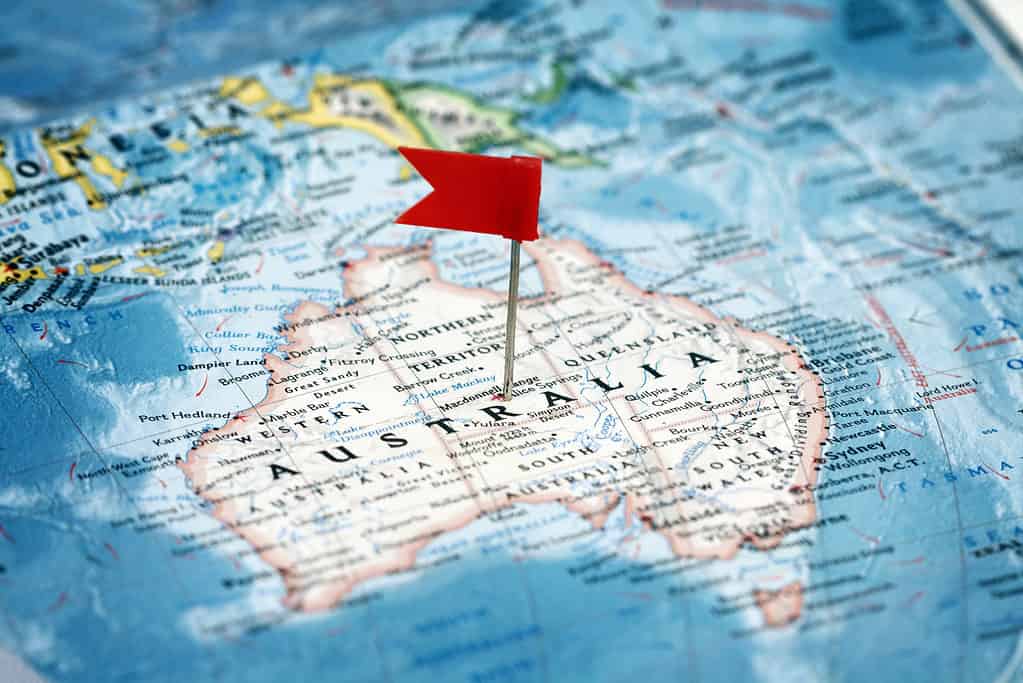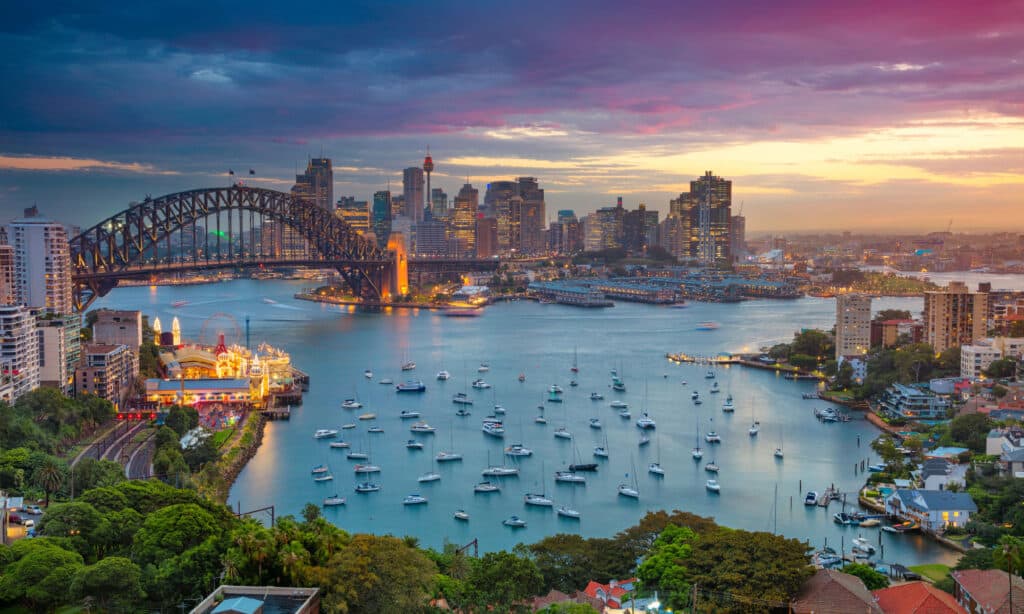Key Points:
- Sydney Harbour is known for the iconic Australian structures of the Sydney Harbour Bridge and the Sydney Opera House. It’s also the focal point for Sydney New Year’s Eve celebrations and the starting point of the Sydney to Hobart Yacht Race.
- The European colonization of Australia began in 1788 when the British First Fleet landed in Sydney Cove (now the Circular Quay part of Sydney Harbour).
- The harbor is 30 feet (10 meters) deep at its shallowest and can reach 155 feet (47 meters) deep.
Located in Sydney, Sydney Harbour opens up to the South Pacific Ocean and the Tasman Sea. Sydney is on the southeastern coast of Australia, about equidistant from Brisbane to the north and Melbourne to the south. It is the capital city of New South Wales and the second largest city in Australia. Up until April 2023, Sydney was the largest city in Australia but was surpassed by a hair by Melbourne when city lines were adjusted.
While two of the most recognizable aspects of the Sydney skyline are the iconic Sydney Harbour Bridge and the Sydney Opera House, the harbor they surround is just as fascinating. It is home to amazing ocean life, popular tourist attractions and a major port for entrance to the city.
The Founding of Sydney
Sydney was the home of the indigenous Gadigal people, a clan of the Eora Nation, for thousands of years. Due to its location on the water, it was an area rich in resources such as animals, food, and water. Aboriginal rock engravings can be found around the city and today, organizations in Sydney and its surrounding areas make efforts to recognize and pay tribute to the traditional owners of the land.
The European colonization of Australia began in 1788 when the First Fleet, a group of 11 British ships carrying English colonists and convicts, landed in Sydney Cove (now the Circular Quay part of Sydney Harbour). They established a colony there, which they called New South Wales. There were conflicts over land and resources between these first settlers and the indigenous people who lived there. Sydney became recognized as a city in 1842 and was the biggest city in Australia for many, many years.
Today, Sydney is the second-largest city in Australia with a population of more than 5 million people. It is a major center of arts and culture in Australia as well as a port for shipping goods.

Sydney is a major center of arts and culture in Australia as well as a port for shipping goods.
©iStock.com/AlexKosev
Where Is Sydney Harbour Located on a Map?
Sydney Harbour is part of Port Jackson, which also includes Middle Harbour, North Harbour, Darling Harbour, and the Lane Cove and Parramatta rivers. It is an inlet of the Tasman Sea, which is part of the South Pacific Ocean. It has more than 150 miles (241 kilometers) of shoreline.
South of the harbor’s Circular Quay, a tourism hub that also houses ferries and international cruise liners, is the city’s central business district. The harbor area is the focal point for Sydney New Year’s Eve celebrations and the starting point of the Sydney to Hobart Yacht Race.
How Deep Is Sydney Harbour?
Its depth depends on the exact location in the harbor and the tides. At its shallowest point, Sydney Harbour is 30 feet (10 meters) deep and at its deepest it is 155 feet (47 meters). This allows boats to make use of the harbor for everything from maritime shipping to cruising. Smaller boats like kayaks and canoes can also paddle around the harbor, although there are some restrictions on where they can go.
Sydney Harbour Bridge
Like in many other coastal areas, bridges are a big part of getting around and dominate the visual landscape in Sydney. The largest and most impressive is the Sydney Harbour Bridge. It is a steel arch bridge that is known as “The Coathanger” due to its shape. It is very long at 3,770 feet (1,149 meters) and goes all the way across Sydney Harbour. In many depictions of Sydney, the Sydney Harbour Bridge is featured front and center along with the Sydney Opera House.
The bridge is open to vehicle traffic on eight lanes, as well as pedestrian traffic and bike traffic. Each has its own dedicated path. Construction of the bridge was completed in 1932 and it has been a notable shape in the Sydney skyline ever since. The bridge connects the Sydney central business district (CBD) with the North Shore.
The CBD is the downtown heart of Sydney and the site of many historic landmarks. George Street runs through the area and serves as the main road, although the entire area has bustling side streets with plenty of shops, restaurants, and businesses. The area has world-class museums and performance venues, including the Sydney Opera House, the Museum of Sydney, and the Theatre Royal.
Sydney’s North Shore is a suburban region and is the location of some notable homes, including Admiralty House, the Governor-General of Australia’s official residence in Sydney, and Kirribilli House, the Prime Minister of Australia’s official residence in Sydney. It has numerous gardens and natural areas. It does not have legally defined boundaries but refers to the general area.

The Sydney Harbour Bridge is an iconic landmark.
©iStock.com/RudyBalasko
Sydney Opera House
Sydney Harbour is probably most known for the Sydney Opera House. In fact, this building is one of the most recognizable aspects of Australia as a whole. It was designed to look like sails and sits right next to the harbor itself, offering breathtaking views of its architecture next to the water. This further reinforces the sail-like quality of the building. Inside, it has numerous theaters designed to provide perfect acoustics and performance spaces.
Design and construction took almost 20 years. The initial proposals were submitted as part of an international design competition. Danish architect Jørn Oberg Utzon won in 1957 and work began the following year. Construction was not complete until 1973.
Opera Australia, the Sydney Theatre Company, and the Sydney Symphony Orchestra all reside in the venue, as well as others. There are also visiting performers and companies. There are more than 40 shows each week. Even if you do not want to see a show, you can always learn more about the architectural masterpiece through one of the guided tours.
What to Do in Sydney Harbour
As the center of a major Australian city, Sydney Harbour has plenty of attractions and things to do. You can enjoy sightseeing on land but there are also fun activities that you can try in the harbor itself.
Seeing Sydney Harbour from a Ferry
Seeing Sydney from the water is a great way to take in the many sights and learn more about the port city’s history. Try a ferry tour that will take you around the harbor. Many include food and beverages available as well as a knowledgeable guide that can tell you the history of the region as you tour. Dinner cruises are also popular. These can be formal or informal, depending on the offerings. You will also be treated to stunning night views of the harbor.
If you are staying for a longer visit, consider booking a ferry cruise along with other sightseeing trips. One of the best zoos in Australia, Taronga Zoo in Mosman is a good place to spend some time in the morning or afternoon, followed by a ferry trip back downtown. Whale watching is another popular excursion by boat.

Taronga Zoo Sydney is one of Australia’s best zoos and can be accessed by ferry.
©FiledIMAGE/Shutterstock.com
Kayaking and Water Sports
Sydney Harbour is a great place to kayak or canoe. Because it is a busy commercial harbor, it’s best to stay close to shore and follow posted signs for safety. Wearing a life jacket and some sort of reflective or lit device are also good ideas.
The northern shore of Sydney Harbour is the best place for kayaking and canoeing. It tends to be less busy with commercial shipping and power boats. This allows kayakers and canoers to enjoy their time on the water without worrying about conflicting with traffic. There are a few areas prohibited to paddlers, including Sydney Cove, Neutral Bay, and Woolloomooloo Bay.
Natural Areas and Wildlife
Australia is known for its amazing (and often dangerous) wildlife. In various locations around the nation, you can see penguins, sharks, and dolphins any time of year. Humpback whales also make stops along the country’s coastline during their migration pattern. Fur seals are also a common sight in coastal waters and oceans, with a notable seal even sunbathing outside the Sydney Opera House.
It’s important to leave wildlife alone, even in a busy city harbor like Sydney’s. The Wild Sydney Harbour project educates the public on the wild animals that call Sydney Harbour home as well as how they can help conserve both the animals and their environment. They also invite people to log their sitings of these animals, especially fur seals, and dolphins, which they are currently tracking.
The photo featured at the top of this post is © wasiolka/Shutterstock.com
Thank you for reading! Have some feedback for us? Contact the AZ Animals editorial team.






